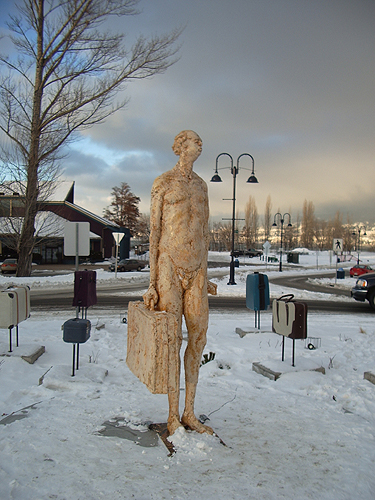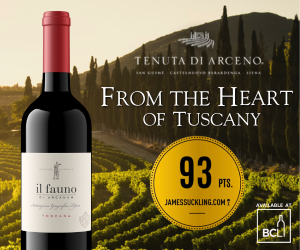Wine is a serious business but not always an earnest business, as Red Rooster Winery's Beat and Prudence Mahrer illustrate.

They have adopted Frank the Baggage Handler, the gangly nude statue that was initially erected last fall in nearby Penticton and created such outrage that the city covered Frank's privates. When that did not save Frank from vandalism, the sculpture was taken down altogether.
On June 25, a newly repaired Frank will be unveiled by sculptor Michael Hermesh in its new home, the Red Rooster tasting room. Later in the summer, Red Rooster will release a red wine called - what else? - Cabernet Frank. Bottles will be signed by the artist and some of the proceeds will pay for the recent cosmetic surgery on the statue.
It is not that the Mahrers are courting controversy just to drive wine sales. The second floor of their magnificent new Naramata Road winery, which opened last year, includes a gallery with continual displays of the works of top local artists. Wine and art, Prudence Mahrer says, have much in common.
A self-described "fun-loving" couple, the Mahrers have a tradition of doing things that lighten up the atmosphere in the tasting room. When they opened their original Naramata winery in 1997 (a small 3,000 square foot building), they announced that Prince Charles would attend and, for years, displayed the prince's polite letter declining the invitation.
Of course, they had not told the prince that the pet after whom the winery was named was a rooster called Prince Charles, who indeed was at the opening, since he lived in a hut beside the driveway. By the time they relocated last year to their much larger and more visible winery, the pet had expired. Frank the Baggage Handler should last longer, assuming Penticton's humourless vandals don't invade Red Rooster.
The Mahrers, former operators of fitness salons in Switzerland, immigrated to the Okanagan in 1990. They bought an orchard just outside Naramata and quickly determined that apples were not going to provide a living. They planted grapes the following year and opened the winery soon after the vineyard began producing.
As fun-loving as the owners are, they also seem to be demanding employers, for a succession of winemakers have proceeded through Red Rooster from the beginning and the wine styles have taken a while to settle in.
Currently, the young man in the hot seat is Langley-born Richard Kanazawa. His colourful résumé includes a brief stint as a professional rugby player in Japan. On his return to Canada, he got a job delivering wine for Domaine de Chaberton winery. That fired his interest in wine: he worked there for eight years and, because there was then no wine program in the province, got a diploma in food technology from the British Columbia Institute of Technology.
In 2002 he went to Australia. "I couldn't get a cellar hand job up here," he says. There, he studied at Charles Sturt University and made wine with, among others, Simon Gilbert, a solid mid-sized producer.
Kanazawa returned in the summer of 2004, circulated his beefed-up résumé and was snapped up by Red Rooster. Last fall, working in the well-equipped new winery, he handled the production of about 15,000 cases of wine.
Judging from the 2004 whites already released and from barrel tastings of the red wines, Kanazawa's style is to craft wines that are fresh, with clean fruit and, in the case of the reds, an accessibility that reflects what he learned in Australia.
The winery's 2004 Pinot Blanc has a core of tropical fruit, including pineapple, and a crisp finish.
The winery has begun to attract a following for its Gewürztraminer ever since winning a Lieutenant Governor's award for excellence for its 2002 Alsace-style Gewürztraminer. The 2004 vintage of the variety continues to show an award-winning power, with spicy aromas and lichee flavours.
The winery's 2004 reds remain in tank or barrels. The varieties - Merlot, Cabernet Sauvignon and Cabernet Franc - all display plum and berry flavours and long but soft tannins. Kanazawa has been given all the barrels he needs for aging the premium reds, with ample space for them in the winery. "Because I have the space, I don't need to compromise anything," he says.
Those barrels also include the winery's soon-to-be released 2003 The Golden Egg, Red Rooster's super-premium $50 red a 75% Merlot, 15% Cabernet Sauvignon and 10% Cabernet Franc. Firm, dark in colour and rich with plum and chocolate notes, this is a 90-point wine.
Made from the winery's best fruit, this is only the second vintage of The Golden Egg (the first was 2001; none was made in 2002). Maximum production is 500 cases.
Kanazawa will have more varietals for his Australian-acquired touch in the future. Red Rooster has just planted Syrah and Viognier.
A footnote: Red Rooster's original winery and vineyard has been acquired by a group of wine-loving investors from Alberta. It is opening this summer as Therapy Vineyards, with wines made for them by Red Rooster.
John Schreiner is author of The Wineries of British Columbia.
 quicksearch
quicksearch





